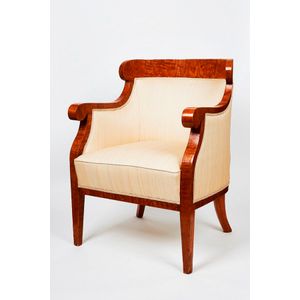George IV Scroll Arm Library Chair with Fluted Legs
You must be a subscriber, and be logged in to view price and dealer details.
Subscribe Now to view actual auction price for this item
When you subscribe, you have the option of setting the currency in which to display prices to $Au, $US, $NZ or Stg.
- Castors - Wheels, fitted especially to chair legs, couches, tables and some smaller pieces of furniture, to enable them to be easily moved about. The earliest castors were of brass, with shanks fitting into the base of the leg, and the wheels often made of leather. In the late 18th century, brass 'bucket' or 'cup' castors were introduced, either rounded or square, fitting directly over the end of the leg and held in place with screws. The wheels were generally solid brass. Bucket/cup castors continued in use throughout the 19th century and indeed are still made today. In the later 19th century wheels were sometimes made of wood, china, either white or brown, and sometimes of steel.
- Rail - A term used by cabinet makers for the horizontal sections of the frame of an item such as a chair or settee which have a front rail, a back rail and two side rails, and also on a door or carcase, where the rails are joined to the vertical framings.
- George Iv - George IV (1762 ? 1830) was king of the United Kingdom of Great Britain and Ireland and king of Hanover from 1820, until his own death in 1830. From 1811 until his accession in 1820, he served as Prince Regent during his father's final mental illness.
In English furniture design, his reign from 1811 to 1830 is known as the Regency period. - Fluting - A form of decoration found on many pieces of furniture, as well as ceramics, silver and clocks, in which round-bottomed grooves, of varying width and depth, are let into columns, pilasters, legs. As a general rule, flutes are cut in the vertical, though they may follow a turned leg in a spiral pattern. In cross-section, they may be described as a series of 'U' shapes, rising and narrowing at each end of the groove. Fluting is the opposite of reeding, with which fluting is often associated.
This item has been included into following indexes:
- chairs, singles - Georgian 550
- chairs, singles / pairs / threes, style or period
Visually similar items

Six Regency mahogany dining chairs, c. 1820, with carved top rails and green velvet seats (6). Height 85 cm

Pair of French Art Deco quilted Ash armchairs, c. 1930, with curved backs, seats and sides upholstered in a cream fabric, each raised on two front square tapered legs and two back saber legs (2), height 87 cm. Provenance: Copeland & de Soos, Woollahra, c.

Set of six Regency mahogany dining chairs, c. 1820, comprising five dining chairs and one carver, each with carved back rail, seat covered in early Japanese silk obi fabric, together with a matching carver with pink upholstered seat, back rail (A/F) (7), h

Set of eight Victorian mahogany balloon back chairs two carvers, six singles, green leather upholstery (8). Height 89 cm width 53 cm
